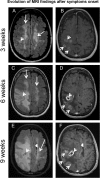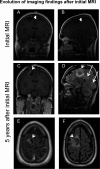Glioblastoma in natalizumab-treated multiple sclerosis patients
- PMID: 28695151
- PMCID: PMC5497532
- DOI: 10.1002/acn3.428
Glioblastoma in natalizumab-treated multiple sclerosis patients
Abstract
We present two natalizumab-treated multiple sclerosis patients who developed glioblastoma multiforme (GBM) with variable outcomes. One patient had an isocitrate dehydrogenase (IDH)-wildtype GBM with aggressive behavior, who declined treatment and died 13 weeks after symptoms onset. The other patient underwent resection of an IDH-mutant secondary GBM that arose from a previously diagnosed grade II astrocytoma. He is still alive 5 years after the diagnosis of GBM. JC virus was not detected in either case. Whether natalizumab played a role in the development of GBM in those patients deserves further investigation.
Figures



References
-
- Stupp R, Mason WP, Van den Bent MJ, et al. Radiotherapy plus concomitant and adjuvant temozolomide for glioblastoma. N Engl J Med 2005;352:987–996. - PubMed
-
- Compston A, Coles A. Multiple sclerosis. Lancet 2008;372:1502–1517. - PubMed
-
- Polman CH, O'Connor PW, Havrdova E, et al. A randomized, placebo‐controlled trial of natalizumab for relapsing multiple sclerosis. N Engl J Med 2006;354:899–910. - PubMed
-
- Rudick RA, Stuart WH, Calabresi PA, et al. Natalizumab plus interferon beta‐1a for relapsing multiple sclerosis. N Engl J Med 2006;354:911–923. - PubMed
Grants and funding
LinkOut - more resources
Full Text Sources
Other Literature Sources

